Factors Determining Product Supply at Marks and Spencer - Report
VerifiedAdded on 2020/12/09
|6
|794
|216
Report
AI Summary
This report examines the factors influencing product supply, using Marks and Spencer (M&S) as a case study. It defines supply and explores various determinants such as price, natural conditions, transport conditions, and technology. The report highlights the direct relationship between product prices and supply, emphasizing how price fluctuations can impact supply. It also discusses the role of natural conditions, like weather, in influencing the supply of agricultural and seasonal goods. Furthermore, the report underlines the importance of efficient transport and advanced technology in ensuring timely product delivery and increased production. The availability and cost of factors like labor, raw materials, and equipment also play a vital role in influencing the supply chain. The conclusion emphasizes the significance of understanding and managing these factors to optimize product supply and meet market demand effectively.
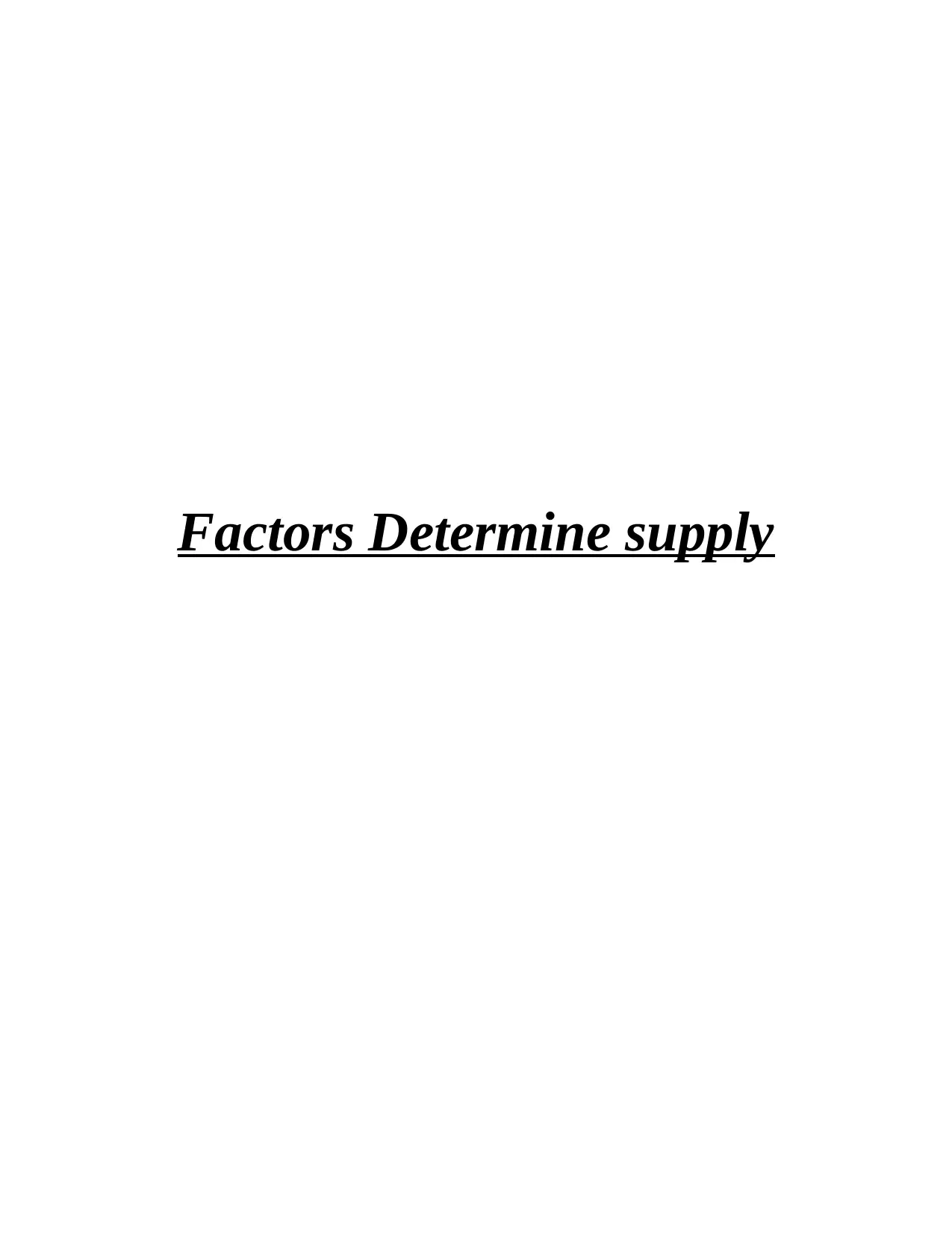
Factors Determine supply
Paraphrase This Document
Need a fresh take? Get an instant paraphrase of this document with our AI Paraphraser
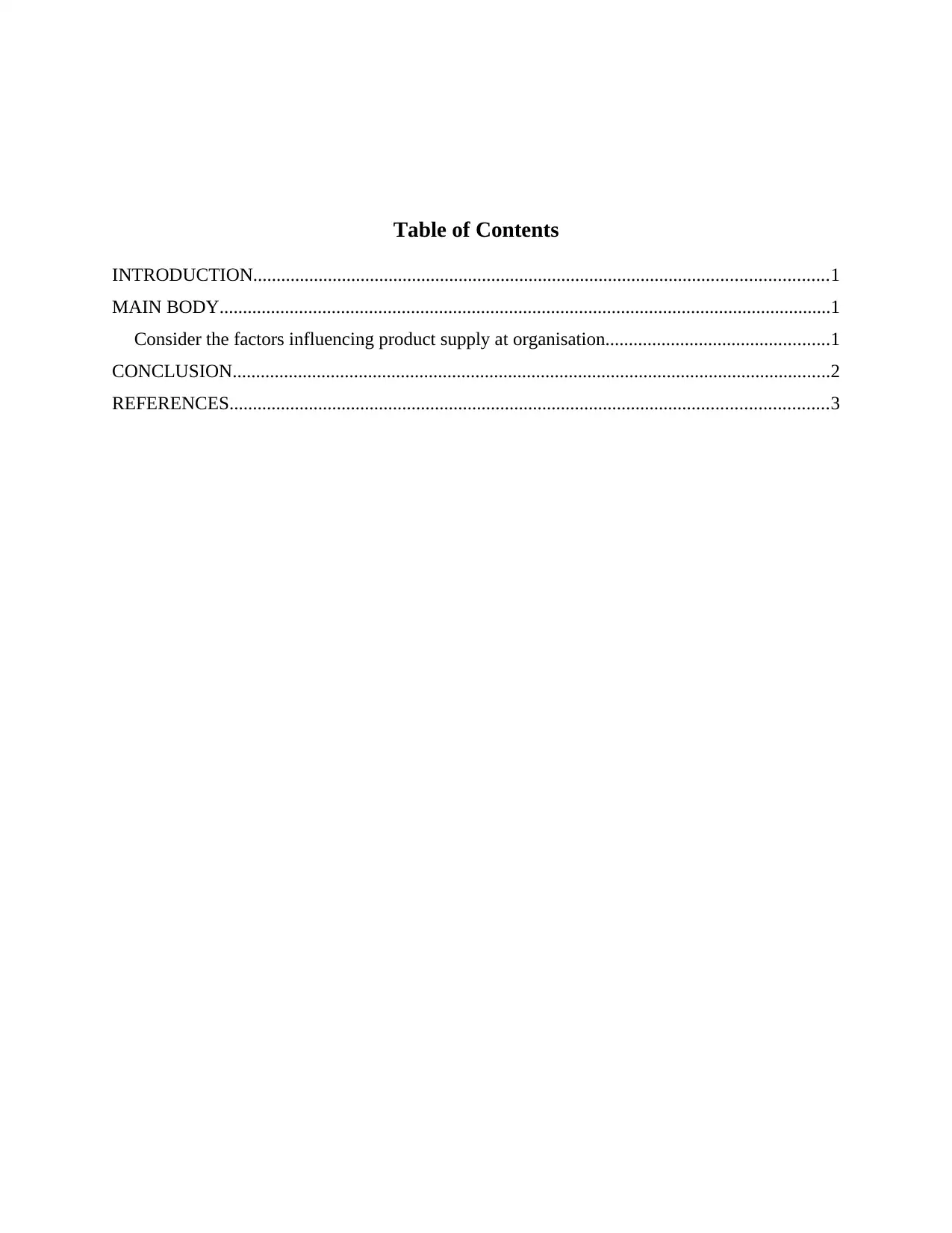
Table of Contents
INTRODUCTION...........................................................................................................................1
MAIN BODY...................................................................................................................................1
Consider the factors influencing product supply at organisation................................................1
CONCLUSION................................................................................................................................2
REFERENCES................................................................................................................................3
INTRODUCTION...........................................................................................................................1
MAIN BODY...................................................................................................................................1
Consider the factors influencing product supply at organisation................................................1
CONCLUSION................................................................................................................................2
REFERENCES................................................................................................................................3

⊘ This is a preview!⊘
Do you want full access?
Subscribe today to unlock all pages.

Trusted by 1+ million students worldwide
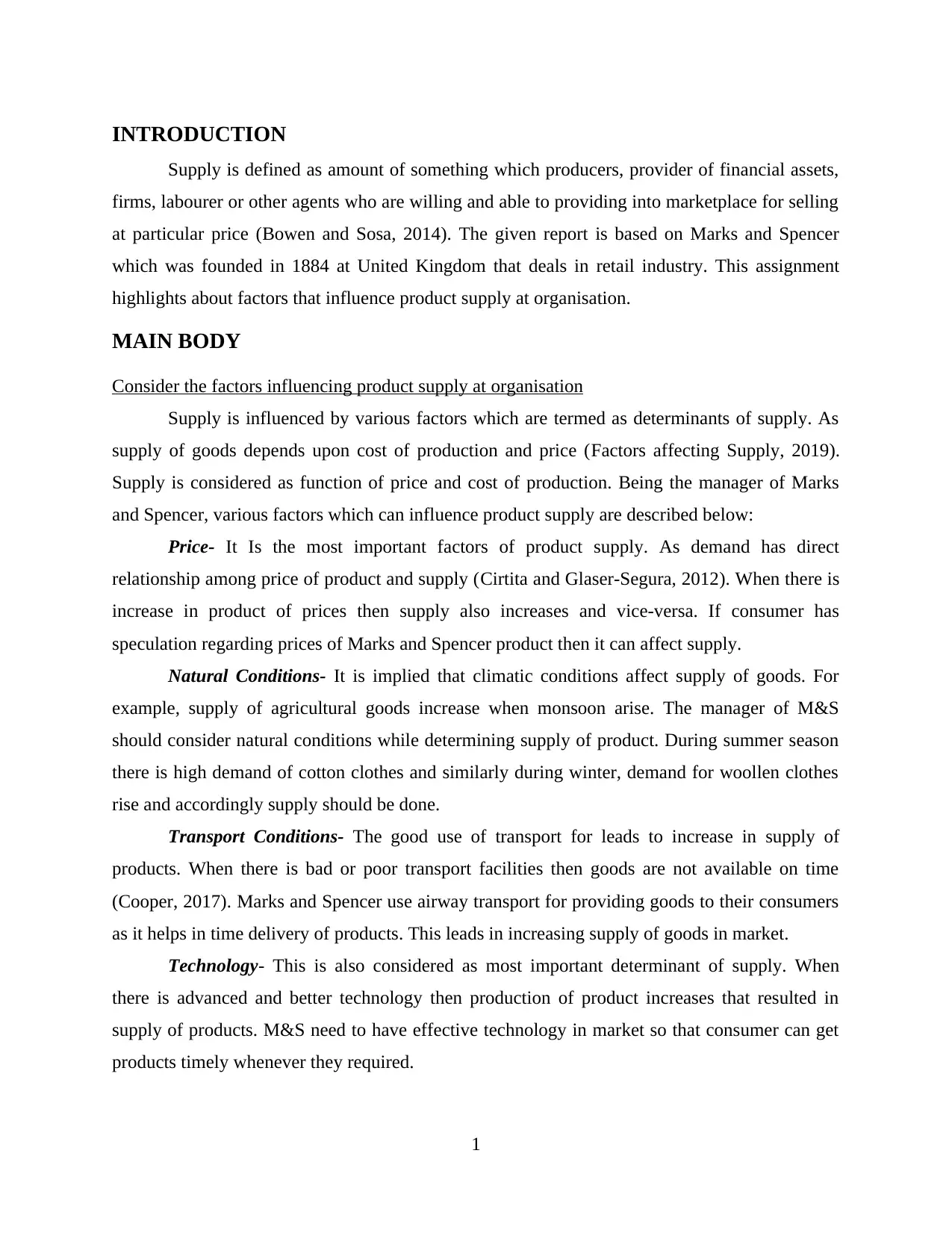
INTRODUCTION
Supply is defined as amount of something which producers, provider of financial assets,
firms, labourer or other agents who are willing and able to providing into marketplace for selling
at particular price (Bowen and Sosa, 2014). The given report is based on Marks and Spencer
which was founded in 1884 at United Kingdom that deals in retail industry. This assignment
highlights about factors that influence product supply at organisation.
MAIN BODY
Consider the factors influencing product supply at organisation
Supply is influenced by various factors which are termed as determinants of supply. As
supply of goods depends upon cost of production and price (Factors affecting Supply, 2019).
Supply is considered as function of price and cost of production. Being the manager of Marks
and Spencer, various factors which can influence product supply are described below:
Price- It Is the most important factors of product supply. As demand has direct
relationship among price of product and supply (Cirtita and Glaser-Segura, 2012). When there is
increase in product of prices then supply also increases and vice-versa. If consumer has
speculation regarding prices of Marks and Spencer product then it can affect supply.
Natural Conditions- It is implied that climatic conditions affect supply of goods. For
example, supply of agricultural goods increase when monsoon arise. The manager of M&S
should consider natural conditions while determining supply of product. During summer season
there is high demand of cotton clothes and similarly during winter, demand for woollen clothes
rise and accordingly supply should be done.
Transport Conditions- The good use of transport for leads to increase in supply of
products. When there is bad or poor transport facilities then goods are not available on time
(Cooper, 2017). Marks and Spencer use airway transport for providing goods to their consumers
as it helps in time delivery of products. This leads in increasing supply of goods in market.
Technology- This is also considered as most important determinant of supply. When
there is advanced and better technology then production of product increases that resulted in
supply of products. M&S need to have effective technology in market so that consumer can get
products timely whenever they required.
1
Supply is defined as amount of something which producers, provider of financial assets,
firms, labourer or other agents who are willing and able to providing into marketplace for selling
at particular price (Bowen and Sosa, 2014). The given report is based on Marks and Spencer
which was founded in 1884 at United Kingdom that deals in retail industry. This assignment
highlights about factors that influence product supply at organisation.
MAIN BODY
Consider the factors influencing product supply at organisation
Supply is influenced by various factors which are termed as determinants of supply. As
supply of goods depends upon cost of production and price (Factors affecting Supply, 2019).
Supply is considered as function of price and cost of production. Being the manager of Marks
and Spencer, various factors which can influence product supply are described below:
Price- It Is the most important factors of product supply. As demand has direct
relationship among price of product and supply (Cirtita and Glaser-Segura, 2012). When there is
increase in product of prices then supply also increases and vice-versa. If consumer has
speculation regarding prices of Marks and Spencer product then it can affect supply.
Natural Conditions- It is implied that climatic conditions affect supply of goods. For
example, supply of agricultural goods increase when monsoon arise. The manager of M&S
should consider natural conditions while determining supply of product. During summer season
there is high demand of cotton clothes and similarly during winter, demand for woollen clothes
rise and accordingly supply should be done.
Transport Conditions- The good use of transport for leads to increase in supply of
products. When there is bad or poor transport facilities then goods are not available on time
(Cooper, 2017). Marks and Spencer use airway transport for providing goods to their consumers
as it helps in time delivery of products. This leads in increasing supply of goods in market.
Technology- This is also considered as most important determinant of supply. When
there is advanced and better technology then production of product increases that resulted in
supply of products. M&S need to have effective technology in market so that consumer can get
products timely whenever they required.
1
Paraphrase This Document
Need a fresh take? Get an instant paraphrase of this document with our AI Paraphraser
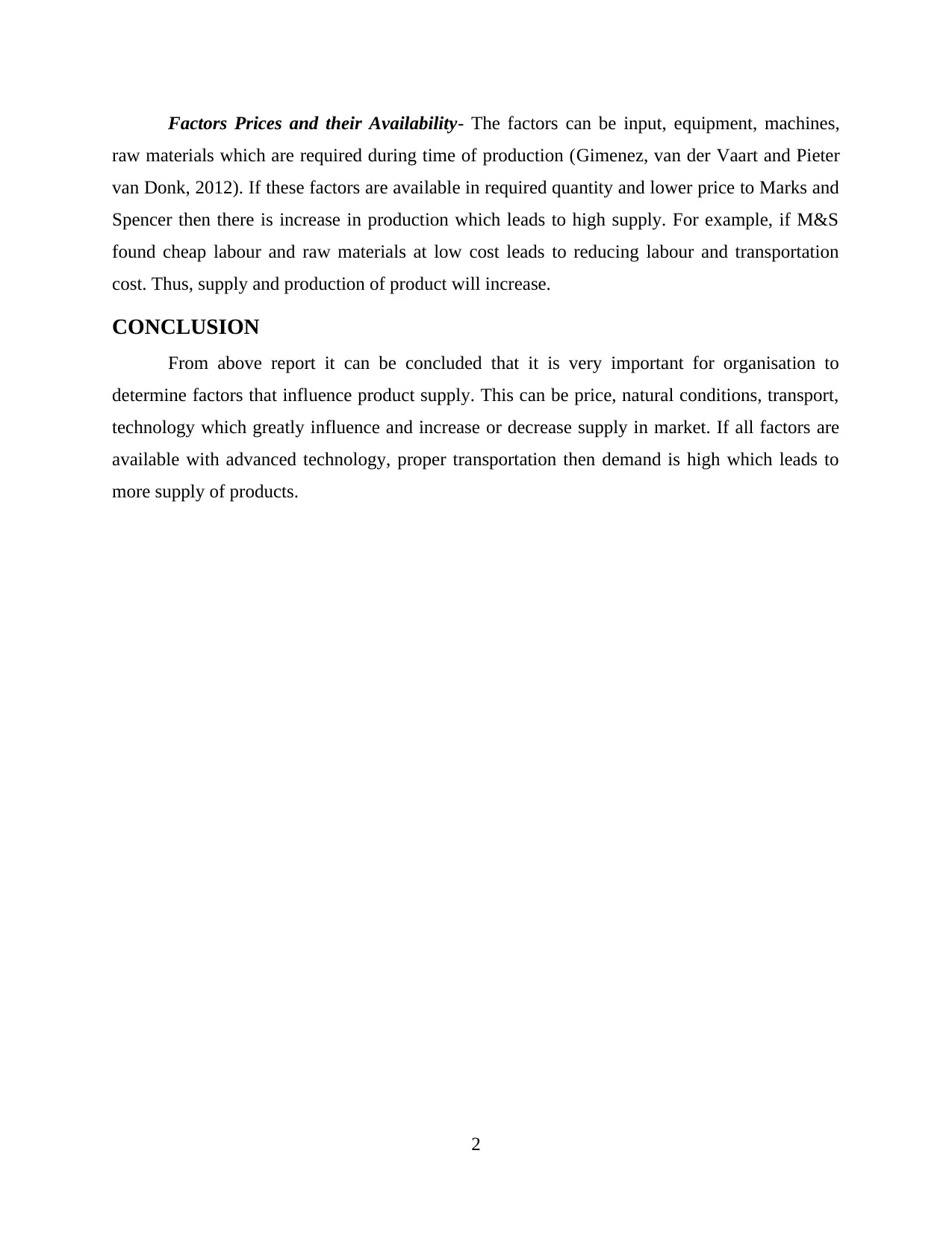
Factors Prices and their Availability- The factors can be input, equipment, machines,
raw materials which are required during time of production (Gimenez, van der Vaart and Pieter
van Donk, 2012). If these factors are available in required quantity and lower price to Marks and
Spencer then there is increase in production which leads to high supply. For example, if M&S
found cheap labour and raw materials at low cost leads to reducing labour and transportation
cost. Thus, supply and production of product will increase.
CONCLUSION
From above report it can be concluded that it is very important for organisation to
determine factors that influence product supply. This can be price, natural conditions, transport,
technology which greatly influence and increase or decrease supply in market. If all factors are
available with advanced technology, proper transportation then demand is high which leads to
more supply of products.
2
raw materials which are required during time of production (Gimenez, van der Vaart and Pieter
van Donk, 2012). If these factors are available in required quantity and lower price to Marks and
Spencer then there is increase in production which leads to high supply. For example, if M&S
found cheap labour and raw materials at low cost leads to reducing labour and transportation
cost. Thus, supply and production of product will increase.
CONCLUSION
From above report it can be concluded that it is very important for organisation to
determine factors that influence product supply. This can be price, natural conditions, transport,
technology which greatly influence and increase or decrease supply in market. If all factors are
available with advanced technology, proper transportation then demand is high which leads to
more supply of products.
2
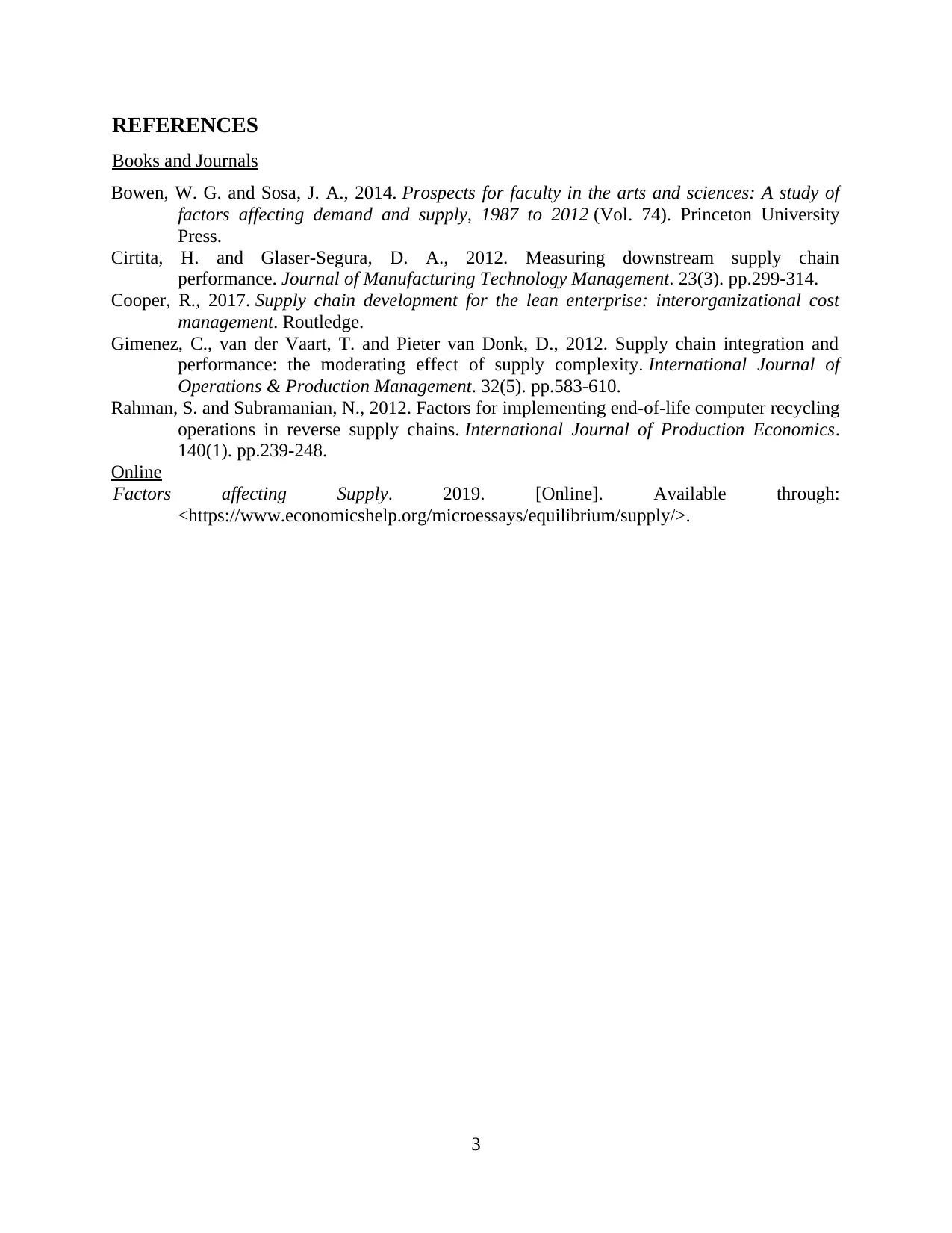
REFERENCES
Books and Journals
Bowen, W. G. and Sosa, J. A., 2014. Prospects for faculty in the arts and sciences: A study of
factors affecting demand and supply, 1987 to 2012 (Vol. 74). Princeton University
Press.
Cirtita, H. and Glaser-Segura, D. A., 2012. Measuring downstream supply chain
performance. Journal of Manufacturing Technology Management. 23(3). pp.299-314.
Cooper, R., 2017. Supply chain development for the lean enterprise: interorganizational cost
management. Routledge.
Gimenez, C., van der Vaart, T. and Pieter van Donk, D., 2012. Supply chain integration and
performance: the moderating effect of supply complexity. International Journal of
Operations & Production Management. 32(5). pp.583-610.
Rahman, S. and Subramanian, N., 2012. Factors for implementing end-of-life computer recycling
operations in reverse supply chains. International Journal of Production Economics.
140(1). pp.239-248.
Online
Factors affecting Supply. 2019. [Online]. Available through:
<https://www.economicshelp.org/microessays/equilibrium/supply/>.
3
Books and Journals
Bowen, W. G. and Sosa, J. A., 2014. Prospects for faculty in the arts and sciences: A study of
factors affecting demand and supply, 1987 to 2012 (Vol. 74). Princeton University
Press.
Cirtita, H. and Glaser-Segura, D. A., 2012. Measuring downstream supply chain
performance. Journal of Manufacturing Technology Management. 23(3). pp.299-314.
Cooper, R., 2017. Supply chain development for the lean enterprise: interorganizational cost
management. Routledge.
Gimenez, C., van der Vaart, T. and Pieter van Donk, D., 2012. Supply chain integration and
performance: the moderating effect of supply complexity. International Journal of
Operations & Production Management. 32(5). pp.583-610.
Rahman, S. and Subramanian, N., 2012. Factors for implementing end-of-life computer recycling
operations in reverse supply chains. International Journal of Production Economics.
140(1). pp.239-248.
Online
Factors affecting Supply. 2019. [Online]. Available through:
<https://www.economicshelp.org/microessays/equilibrium/supply/>.
3
⊘ This is a preview!⊘
Do you want full access?
Subscribe today to unlock all pages.

Trusted by 1+ million students worldwide
1 out of 6
Related Documents
Your All-in-One AI-Powered Toolkit for Academic Success.
+13062052269
info@desklib.com
Available 24*7 on WhatsApp / Email
![[object Object]](/_next/static/media/star-bottom.7253800d.svg)
Unlock your academic potential
Copyright © 2020–2025 A2Z Services. All Rights Reserved. Developed and managed by ZUCOL.





